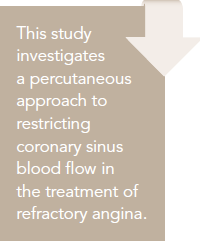Publication
Article
Cardiology Review® Online
Novel Treatment for Refractory Angina Using a Coronary Sinus Reducer Device: A Glimmer of Hope
Author(s):
Refractory angina is a loosely defined term generally referring to the persistence of life-impacting angina despite maximal antianginal medications and, when possible, coronary revascularization (percutaneous coronary intervention [PCI] or coronary artery bypass grafting [CABG]). Numerous novel pharmacotherapies and mechanical interventions have been proposed, and studies conducted, to treat patients with refractory angina.

Glenn N. Levine, MD, FAHA, FACC
Review
Verheye S, Jolicoeur EM, Behan MW, et al. Efficacy of a device to narrow the coronary sinus in refractory angina. N Engl J Med. 2015;372:519-572.

Refractory angina is a loosely defined term generally referring to the persistence of life-impacting angina despite maximal antianginal medications and, when possible, coronary revascularization (percutaneous coronary intervention [PCI] or coronary artery bypass grafting [CABG]). Numerous novel pharmacotherapies and mechanical interventions have been proposed, and studies conducted, to treat patients with refractory angina.
One such novel intervention is restriction of blood flow in the coronary sinus. Restriction of blood flow in the coronary sinus was first described in the 1930s, and research was pioneered by Claude Beck in the 1950s. A surgical approach was used to partially ligate the coronary sinus, restricting blood flow. Recently, a percutaneous approach to restricting coronary sinus blood flow for the treatment of refractory angina has been investigated.1
Study Details
The Coronary Sinus Reducer for Treatment of Refractory Angina (COSIRA) trial was a study of a novel endoluminal, balloon-expandable, stainless steel, hourglass-shaped device that was specifically designed to be percutaneously implanted in the coronary sinus. The metal mesh device is percutaneously deployed through a preshaped 9-F guiding catheter. Over time, a hyperplastic response in the vessel wall leads to occlusion of the fenestrations in the metal mesh, leaving only the central orifice of the device as a means for blood to transit the coronary sinus.
The study enrolled patients with Canadian Cardiovascular Society (CCS) class III-IV angina, persisting despite maximum tolerated doses of antianginal medications, who were not candidates for revascularization. Additionally, patients needed to have objective evidence of reversible myocardial ischemia, could not have undergone recent revascularization or had recent acute coronary syndrome, and could not have undergone pacemaker or defibrillator lead placement in the right heart.
After catheterization and angiography of the coronary sinus to confirm suitable anatomy, patients were randomized to either device treatment or a sham procedure. Of note, in addition to the sham procedure itself, in order to keep patients blinded as to their treatment, the patients either had conscious sedation or headsets playing music during the procedure. Although the cardiologist performing the procedure obviously was not blinded to patient treatment, all others involved in assessing subjective and objective endpoints were. The primary study endpoint was the proportion of patients with an improvement of at least 2 CCS angina classes at 6-month follow-up.
The study, conducted at 11 centers, enrolled a total of 104 patients. Device-treated and sham-treated patients were reasonably well matched in terms of baseline clinical characteristics, history of prior PCI or CABG, CCS angina class, and number of antianginal medications. Of the 52 patients randomized to device treatment, the device was successfully implanted in 50 patients. Other than 1 periprocedural myocardial infarction, no serious adverse events occurred in the device-treated group over the 6 months of follow-up.
Eighteen of 52 patients (35%) in the device-treated group, compared with8 of 52 patients (15%) in the sham-treated group, had improvement of at least 2 CCS angina classes (P=.02). There was improvement of at least 1 CCS angina class in 71% of the device-treated patients, compared with 42% of the sham-treated patients (P=.003). Quality of life, as assessed by the Seattle Angina Questionnaire, improved 17.6 points (on a 100-point scale) in device-treated patients, compared with 7.6 points in sham-treated patients (P=.03). In terms of objective measures, mean exercise duration improved in the device-treatment and sham-treatment groups by 59 seconds (13%) and 4 seconds (1%), respectively (P= .07), and mean time to ST-segment depression of 1 mm was prolonged by 49 seconds (13%) and 18 seconds (4%), respectively (P= .41).
Commentary
Novel therapies for angina: “Curb your enthusiasm”
Prior to this study, 2 small pilot studies reported improvements in refractory angina using this hourglass-shaped device (referred to as the “Reducer”). This is the first randomized trial to report reductions in angina class using the Reducer.
Several important caveats exist when considering this trial. First, the primary endpoints of this study were subjective, and though the study investigators did their best to truly perform a sham-controlled and patient-blinded study, the possibility that patients still had some reason to know (or at least suspect) whether or not they had received actual device treatment still exists. Second, most of the endpoints of this study, by the very nature of the intended treatment, are relatively “soft” (improvements in more objective assessments were numerically, though not statistically, better in device-treated patients). Third, the number of patients and endpoints was modest, and clearly larger trials need to be performed before this treatment can be accepted as being adequately demonstrated to be of benefit. Such larger trials are also needed to better assess the true degree of benefit to patients. Fourth, and somewhat related to the third point, this is not the first time that notably positive or dramatic results were reported in a major journal on a novel intervention.
While in some cases the notable benefits of the intervention are later confirmed in larger trials (such as with drug-eluting stents), many other times the benefits of the intervention are not replicated or are found to be much more modest (such as with N-acetyl cysteine for the prevention of contrast nephropathy). A 400-patient, single-arm trial in Europe and a phase II, FDA-approved feasibility trial in the United States are reportedly planned.
The mechanism by which device (Reducer) implantation and an increase in coronary sinus pressure could lead to a decrease in angina is unclear. Of note, the study authors themselves acknowledge that such a mechanism is unknown. They state that “The most commonly proposed mechanism of benefit is recruitment of coronary collateral flow, with redistribution from the less ischemic epicardium to the ischemic endocardium.”
The problem of refractory angina is a real and growing one, particularly as coronary artery disease comes to affect more and more of the world’s population and as the age to which the population survives increases. As described by David Jones in a History of Medicine Perspective article in The New England Journal of Medicine,2 numerous novel interventions for the treatment of angina have been attempted over the last century, including interrupting sympathetic innervations to the heart with sympathectomy or alcohol injection, thyroidectomy, ligation of the internal thoracic arteries, and implantation of the internal thoracic arteries into the myocardium (Vineberg procedure), as well as ligation of the coronary sinus as discussed above.
Additional novel treatments that have been tried for the treatment of angina include enhanced external counterpulsation (EECP), extracorporeal shockwave therapy (ESWT), subcutaneous electrical nerve stimulation (SENS), and percutaneous and transmyocardial laser revascularization (PMR and TMLR, respectively).
More recently, therapeutic angiogenesis using gene therapy or cell therapy have been studied, though results to date have been modest at best. Improvements in equipment and techniques have led to increased and renewed interest in chronic total occlusion PCI, and this may be a reasonable treatment strategy in some patients with refractory angina.
At present, first-line therapy in most guidelines remains beta-blockers, nitrates, and calcium channel blockers. Newer pharmacotherapies include ranolazine, ivabradine, and nicorandil. The role of novel mechanical interventions remains to be determined, although the results of the COSIRA trial provide at least a glimmer of hope to the many and increasing number of patients with refractory angina.
References
1. Verheye S, Jolicoeur EM, Behan MW, et al. Efficacy of a device to narrow the coronary sinus in refractory angina. N Engl J Med. 2015;372:519-572.
2. Jones DS. The puzzle of positive results—myocardial revascularization.N Engl J Med. 2015;372:501-503.
3. Henry TD, Satran D, Jolicoeur M. Treatment of refractory angina in patients not suitable for revascularization. Nat Rev Cardiol. 2014;11:78-95.
4. Neale T. Narrowing coronary sinus may provide relief from refractory angina. February 4, 2015. Tctmd website .http://www.tctmd.com/show.aspx?id=127912.
About the Author
Glenn N. Levine, MD, FAHA, FACC, is professor of medicine at Baylor College of Medicine and director of the Cardiac Care Unit at Michael E. DeBakey Medical Center in Houston, TX. He received his MD from Columbia University College of Physicians and Surgeons in New York and completed postdoctoral training in advanced cardiovascular imaging at Baylor College of Medicine/Texas Heart Institute. Dr Levine’s internship, residency, and fellowships in interventional cardiology and cardiology were at Boston University Medical Center. He has coauthored numerous published clinical trials, guidelines, and textbook chapters.






